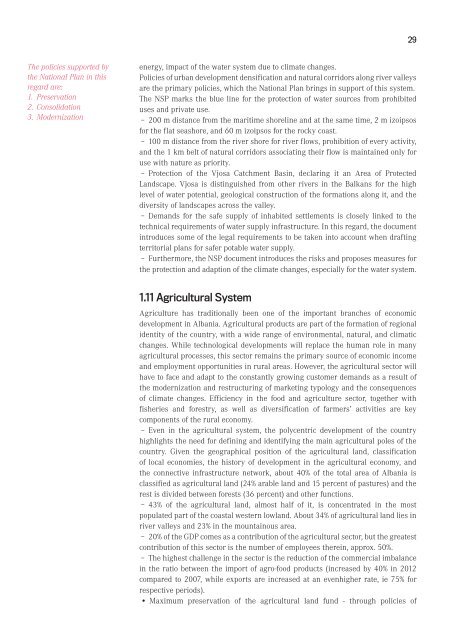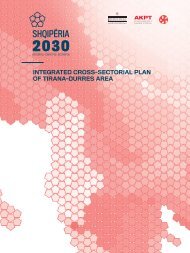First National Documents on Spatial Planning in Albania
Summary of the first 3 National Documents on Spatial Planning for the Republic of Albania: 1. The General National Spatial Plan 2. The Integrated Cross-Sectorial Plan for the Coast 3. The Integrated Cross-Sectorial Plan for the Tirana-Durrës Region
Summary of the first 3 National Documents on Spatial Planning for the Republic of Albania:
1. The General National Spatial Plan
2. The Integrated Cross-Sectorial Plan for the Coast
3. The Integrated Cross-Sectorial Plan for the Tirana-Durrës Region
Create successful ePaper yourself
Turn your PDF publications into a flip-book with our unique Google optimized e-Paper software.
29<br />
The policies supported by<br />
the <str<strong>on</strong>g>Nati<strong>on</strong>al</str<strong>on</strong>g> Plan <strong>in</strong> this<br />
regard are:<br />
1. Preservati<strong>on</strong><br />
2. C<strong>on</strong>solidati<strong>on</strong><br />
3. Modernizati<strong>on</strong><br />
energy, impact of the water system due to climate changes.<br />
Policies of urban development densificati<strong>on</strong> and natural corridors al<strong>on</strong>g river valleys<br />
are the primary policies, which the <str<strong>on</strong>g>Nati<strong>on</strong>al</str<strong>on</strong>g> Plan br<strong>in</strong>gs <strong>in</strong> support of this system.<br />
The NSP marks the blue l<strong>in</strong>e for the protecti<strong>on</strong> of water sources from prohibited<br />
uses and private use.<br />
ʧ 200 m distance from the maritime shorel<strong>in</strong>e and at the same time, 2 m izoipsos<br />
for the flat seashore, and 60 m izoipsos for the rocky coast.<br />
ʧ 100 m distance from the river shore for river flows, prohibiti<strong>on</strong> of every activity,<br />
and the 1 km belt of natural corridors associat<strong>in</strong>g their flow is ma<strong>in</strong>ta<strong>in</strong>ed <strong>on</strong>ly for<br />
use with nature as priority.<br />
ʧ Protecti<strong>on</strong> of the Vjosa Catchment Bas<strong>in</strong>, declar<strong>in</strong>g it an Area of Protected<br />
Landscape. Vjosa is dist<strong>in</strong>guished from other rivers <strong>in</strong> the Balkans for the high<br />
level of water potential, geological c<strong>on</strong>structi<strong>on</strong> of the formati<strong>on</strong>s al<strong>on</strong>g it, and the<br />
diversity of landscapes across the valley.<br />
ʧ Demands for the safe supply of <strong>in</strong>habited settlements is closely l<strong>in</strong>ked to the<br />
technical requirements of water supply <strong>in</strong>frastructure. In this regard, the document<br />
<strong>in</strong>troduces some of the legal requirements to be taken <strong>in</strong>to account when draft<strong>in</strong>g<br />
territorial plans for safer potable water supply.<br />
ʧ Furthermore, the NSP document <strong>in</strong>troduces the risks and proposes measures for<br />
the protecti<strong>on</strong> and adapti<strong>on</strong> of the climate changes, especially for the water system.<br />
1.11 Agricultural System<br />
Agriculture has traditi<strong>on</strong>ally been <strong>on</strong>e of the important branches of ec<strong>on</strong>omic<br />
development <strong>in</strong> <strong>Albania</strong>. Agricultural products are part of the formati<strong>on</strong> of regi<strong>on</strong>al<br />
identity of the country, with a wide range of envir<strong>on</strong>mental, natural, and climatic<br />
changes. While technological developments will replace the human role <strong>in</strong> many<br />
agricultural processes, this sector rema<strong>in</strong>s the primary source of ec<strong>on</strong>omic <strong>in</strong>come<br />
and employment opportunities <strong>in</strong> rural areas. However, the agricultural sector will<br />
have to face and adapt to the c<strong>on</strong>stantly grow<strong>in</strong>g customer demands as a result of<br />
the modernizati<strong>on</strong> and restructur<strong>in</strong>g of market<strong>in</strong>g typology and the c<strong>on</strong>sequences<br />
of climate changes. Efficiency <strong>in</strong> the food and agriculture sector, together with<br />
fisheries and forestry, as well as diversificati<strong>on</strong> of farmers’ activities are key<br />
comp<strong>on</strong>ents of the rural ec<strong>on</strong>omy.<br />
ʧ Even <strong>in</strong> the agricultural system, the polycentric development of the country<br />
highlights the need for def<strong>in</strong><strong>in</strong>g and identify<strong>in</strong>g the ma<strong>in</strong> agricultural poles of the<br />
country. Given the geographical positi<strong>on</strong> of the agricultural land, classificati<strong>on</strong><br />
of local ec<strong>on</strong>omies, the history of development <strong>in</strong> the agricultural ec<strong>on</strong>omy, and<br />
the c<strong>on</strong>nective <strong>in</strong>frastructure network, about 40% of the total area of <strong>Albania</strong> is<br />
classified as agricultural land (24% arable land and 15 percent of pastures) and the<br />
rest is divided between forests (36 percent) and other functi<strong>on</strong>s.<br />
ʧ 43% of the agricultural land, almost half of it, is c<strong>on</strong>centrated <strong>in</strong> the most<br />
populated part of the coastal western lowland. About 34% of agricultural land lies <strong>in</strong><br />
river valleys and 23% <strong>in</strong> the mounta<strong>in</strong>ous area.<br />
ʧ 20% of the GDP comes as a c<strong>on</strong>tributi<strong>on</strong> of the agricultural sector, but the greatest<br />
c<strong>on</strong>tributi<strong>on</strong> of this sector is the number of employees there<strong>in</strong>, approx. 50%.<br />
ʧ The highest challenge <strong>in</strong> the sector is the reducti<strong>on</strong> of the commercial imbalance<br />
<strong>in</strong> the ratio between the import of agro-food products (<strong>in</strong>creased by 40% <strong>in</strong> 2012<br />
compared to 2007, while exports are <strong>in</strong>creased at an evenhigher rate, ie 75% for<br />
respective periods).<br />
Maximum preservati<strong>on</strong> of the agricultural land fund - through policies of
















